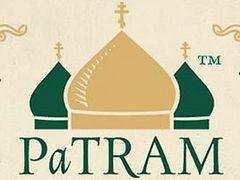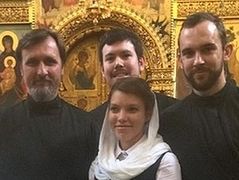Moscow, May 24, 2018
As an Orthodox American in Moscow (and Russia) for the first time, I was delighted to learn that the professional male choir of the Moscow Representation of the Holy Trinity-St. Sergius Lavra, under Vladimir Gorbik, would be presenting a concert, Monastic Chant, during my sojourn in the quintessential Russian city. To attend an Orthodox sacred music concert in a major performing arts center would be almost unthinkable in the United States—it happens sometimes in New York City or Boston, thanks be to God, but sadly, most Americans hardly know what Orthodox Christianity is, let alone having enough enthusiasm for Orthodox music to make any such concert outside of a local church plausible. The music was, of course, entirely in Slavonic, and consisted of the major sung portions of the Orthodox Russian-style Vigil and Divine Liturgy. So, in attending the concert I felt I was having a remarkably Russian experience on many levels.
Yet, while a Russian ensemble sang mostly Russian music for over two hours, I suspect the evening was not typical of most performances in a Moscow concert hall. Conductor Vladimir Gorbik made several presentation choices that enhanced one's perception of the sacred during the evening. No programs were distributed; before each half of the concert, an announcer read through names of the upcoming selections. Neither did the choir accept applause, except before intermission and at the very end of the entire performance. On the one hand, this austere approach meant that I (whose Russian language skills are extremely limited) had no idea what composers I was listening to, unless I recognized a piece. But on the other hand, the audience was entirely free to simply experience the music—free from checking a piece of paper to see “what comes next,” and free to enter into the program, which was a shadow of Orthodox liturgical worship, without the jarring interruption of applause.
Interestingly, a pious Russian friend accompanying me to the concert said she generally does not care for hearing liturgical music in a non-liturgical setting: Hearing the prayers and chant stimulate her to stand and cross herself, typical actions for a participant in Orthodox worship, but not typical for concert goers, even in Russia! I appreciate her point, but to me, the concert was a unique opportunity, rather than an aberration.
In Orthodox liturgical services, worshippers encounter all kinds of stimulation simultaneously: The movement of the clergy and congregation, the bright colors of vestments and icons, the smells of incense and wax candles, and the sounds not only of music, but also of fellow congregants, both young and old! These are all wonderful things, but their very multiplicity and variety mean that worshippers rarely focus in on one element: Sometimes a beautiful musical moment, or light shining on a piece of embroidery will catch the ear or eye and penetrate the heart, but the experience is one of a shifting kaleidoscope, wrapping the people present in an entire world of worship.
The concert, by contrast, was a chance to focus in on one element of Orthodox worship, to really hear the music and prayers that so often wash over the ear during services. In that way, the concert appealed to me as an ascetic experience: The audience sat quietly, almost without movement, for two sequences of music that each lasted about an hour. Rather than feeling that the concert hall was simply an inappropriate place to hear liturgical music, I hoped that having entered into the liturgical music in such a focused way, I might hear it differently—more fully and profoundly—in its proper liturgical setting in the future. Liturgical music is not intended for the concert hall, but the concert was an exercise, not simply an enjoyable evening of music.
And what did I hear during this exercise? To my delight, the choir sang some of my favorite chant settings, as well as beautiful pieces I had never heard before (though I can’t say what they were!). The selections, however, ranged in style from two-part melody and ison chant to elaborate compositions with deeply layered harmonies. That such complex harmonies could be considered monastic chant, along with more simple music, might certainly surprise those who look for an austere style in monastic worship. There is certainly a tradition within Orthodox monasticism for services to be as simple as possible—sometimes foregoing the use of music all together—but there is also a tradition in which monasteries have cathedrals and celebratory feast days, settings in which more elaborate music can be appropriate.
What united all of the selections was not their style or date of composition, but the heartfelt approach of prayerful singing. The singers and conductor were engaged in an ascetic exercise of striving to make the music reflect and enhance the text of the prayers, rather than simply performing music for its own sake. On more than one occasion, Maestro Gorbik reminded his singers to enunciate more precisely, so that the text of the prayers could be clearly heard. Those familiar with his conducting style would have recognized his intense and emotive gestures, as well as his ability to shift the singers seamlessly between powerful and delicate dynamics. The austerity of Orthodox—and monastic—chant is not necessarily the absence of dynamics, emotion, or complexity (though one certainly can encounter such an approach to music in monasteries) but in this case, the discipline of approaching these elements as tools for worship, to be used with discernment.
Although neither Vladimir Gorbik nor the members of the professional choir that sang the concert are monks (at least, not so far as I know), the ensemble was still able to present an evening of monastic chant. The ensemble has experience of this repertoire by virtue of being the professional choir for the Moscow representation church of the Holy Trinity-St. Sergius Lavra, a monastery known to many as the heart of Russian Orthodox spirituality. The light of this spirituality shone during the concert and invited the audience to participate by listening with attentiveness, discipline, and joy—three hallmarks of Orthodox monasticism. May such concerts continue to enrich the prayers of those who sing and those who hear, in the concert hall and in the church, in the monastery and in the parish—and perhaps invite those who do not know Orthodoxy at all to encounter its rich and varied spirituality for the first time.
Sister Margarete (Roeber) is a novice of St. Barbara’s Monastery (OCA) in Santa Paula, CA.
Follow us on Facebook!




